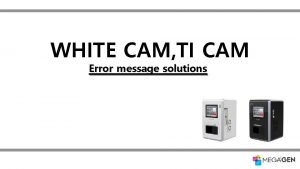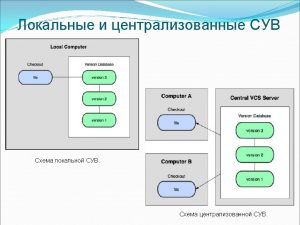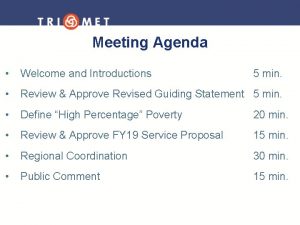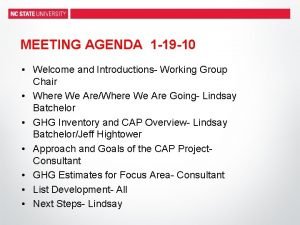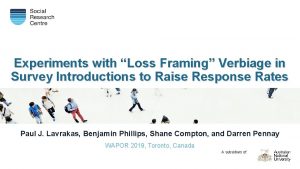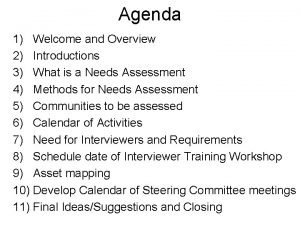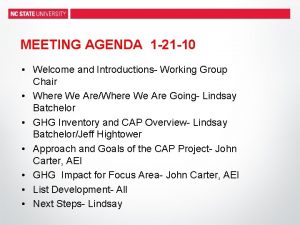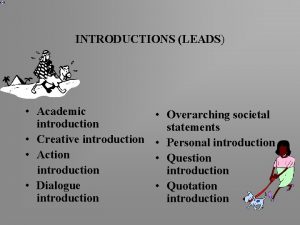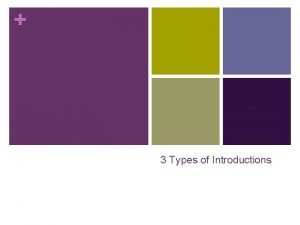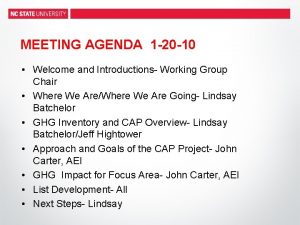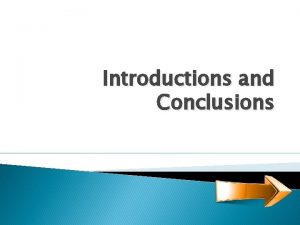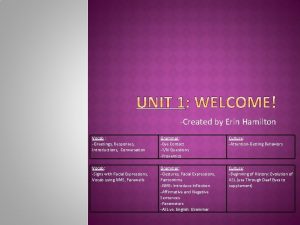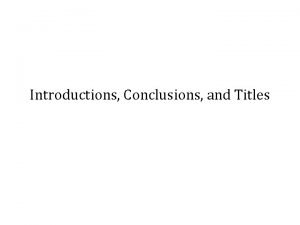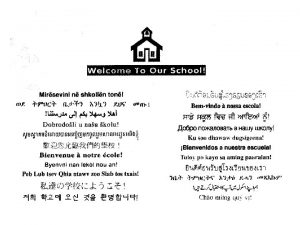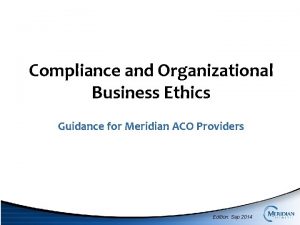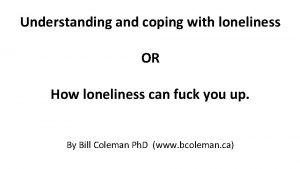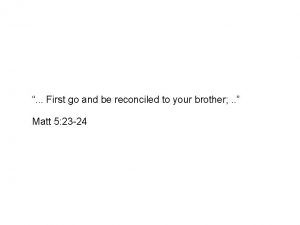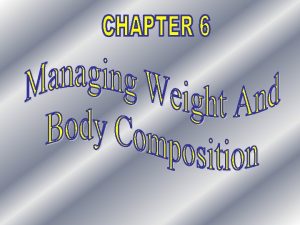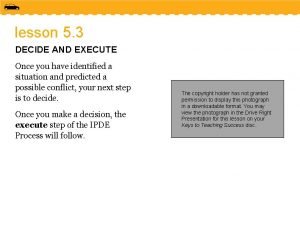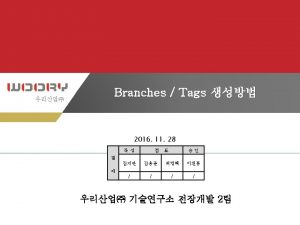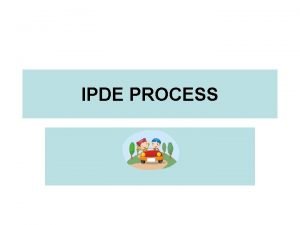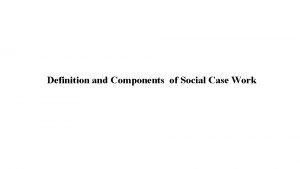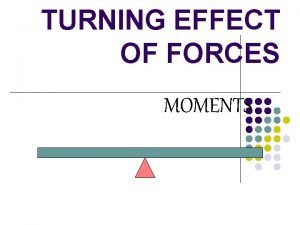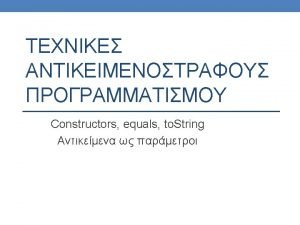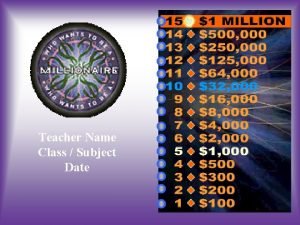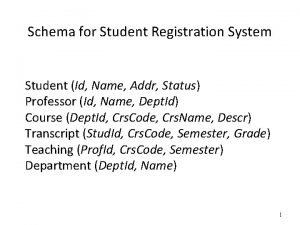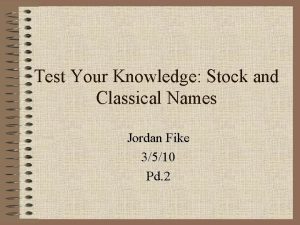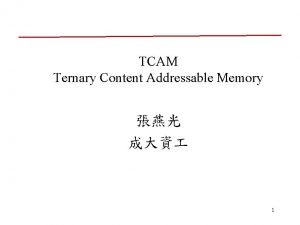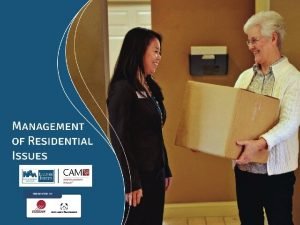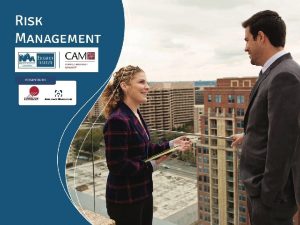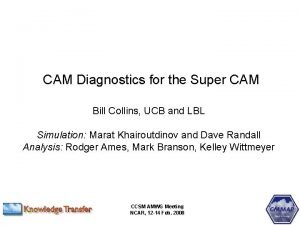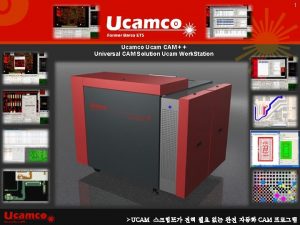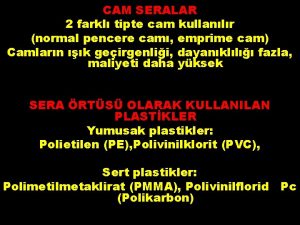California CAM Introductions Your name Where you work

















































































































- Slides: 113

California CAM

Introductions • • • Your name Where you work Your job responsibilities How long you have been in the industry What you hope to get from this class Fair Housing 2

Introductions (Cont’d) • What types of properties do you manage? Senior properties? 55+ or 62+? Project-based subsidized? Military housing? Tax Credit/Bond/Home? Conventional? Mobile home Park? Fair Housing 3

Agenda • • • Fair Housing Laws Government Housing Programs Families with Children People with Disabilities Management Practices Fair Housing Complaints Fair Housing 4

Fair Housing and Accessibility Laws • The Civil Rights Act of 1866 • Title VI of the Civil Rights Act of 1964 • Title VIII of the Civil Rights Act of 1968 (Fair Housing Act) • Section 504 of the Rehabilitation Act of 1973 • Fair Housing Amendments Act of 1988 (FHAA) • Housing for Older Persons Act of 1995 • Americans with Disabilities Act of 1990 Fair Housing Chapter 1 5

The Civil Rights Act of 1866 • Declared all people born in the United States are citizens and have the same rights regardless of race, color or previous condition of slavery or involuntary servitude. • Gives all citizens the same right to inherit, buy, lease, or sell property regardless of race/color. • Was followed by segregation laws (“separate but equal”). • Is an active law today, often cited in cases of intentional racial discrimination. Fair Housing Chapter 1 6

Title VI of the Civil Rights Act of 1964 • Federally subsidized and public housing are covered by this law. • Protects individuals from discrimination based on their race, color, religion or national origin in programs or activities that receive federal financial assistance. Fair Housing Chapter 1 7

Title VIII of the Civil Rights Act of 1968 (Fair Housing Act) This law and its subsequent amendment in 1974, makes it illegal to • refuse to sell or rent, to discriminate against a person in terms, conditions, privileges or advertising; • threaten, coerce, intimidate or interfere with anyone exercising a fair housing right or assisting others who exercise that right; or • indicate any limitation or preference based on race, color, religion, national origin or sex (added in 1974). Fair Housing Chapter 1 8

Section 504 of the Rehabilitation Act of 1973 • Section 504 applies to the availability of services, accessibility, delivery, employment and the administrative responsibilities of organizations toward the disabled if property is receiving federal financial assistance. • Provides protection against discrimination for persons with disabilities in federally-assisted housing and other federal-assistance programs. Fair Housing Chapter 1 9

Fair Housing Amendments Act of 1988 (FHAA) Added two (2) more protected classes: – Familial status – Individuals with disabilities Added “teeth” to the enforcement of fair housing laws Fair Housing Chapter 1 10

Housing for Older Persons Act of 1995 (HOPA) • It eliminated the requirement that 55 and older housing have "significant facilities and services" designed for the elderly. • California has its own specific design elements. • It established “good faith reliance” immunity from damages for persons who believe a 55 and older exemption applies to a certain property if the property so states in writing. Fair Housing Chapter 1 11

Americans With Disabilities Act (ADA) of 1990 • Deals with public accommodations and services operated by private entities and requires that facilities that are open to the public be accessible to persons with disabilities. • This would include the Leasing Office of the apartment community. • People with disabilities who visit the public areas of the property must have access to all services and amenities such as parking, curbs, ramps, stairs, elevators, public drinking fountains, restrooms and public telephones. Fair Housing Chapter 1 12

Federal Protected Classes Race Color Religion National Origin Sex (Sexual Harassment) Familial Status Handicap (“Disability” in California) Fair Housing Chapter 1 13

If You Transfer, Know the Laws It is extremely important that a community manager who transfers from one state to another, or from one city to another, learns the laws particular to that city, county and State. • Always research what differences there may be in the fair housing laws. This includes local ordinances and amendments. Fair Housing Chapter 1 14

California Fair Housing Laws • Rumford Fair Housing Act of 1963 • Fair Employment and Housing Act of 1980 (FEHA) – Made substantially equivalent with Federal Fair Housing Act in 1994 • Unruh Civil Rights Act of 1959 Fair Housing Chapter 1 15

California Fair Employment and Housing Act (FEHA) • It is unlawful for the owner of any housing accommodation to discriminate against any person based on race, color, religion, sexual orientation, national origin, familial status, disability, marital status, ancestry, source of income, gender identity, gender expression or genetic information or an intention to make such a preference, limitation or discrimination. • Covers advertising, financing, land-use practices, covenants, accommodations and modifications, and any other practices related to the rental or purchase of housing. Fair Housing Chapter 1 16

California Protected Classes • • • Ancestry Marital Status Sexual Orientation Source of Income Age (Unruh Act) Medical Condition Gender, gender identity, gender expression Genetic information In 2000, FEHA addressed Perception and Association. Fair Housing Chapter 1 17

Source of Income • Can’t require employment • Legal and verifiable • Paid directly to the tenant or tenant’s representative (not owner) • Must consider all financial resources; cannot prefer employed applicants • Not required to participate in Section 8 Choice Voucher program Fair Housing Chapter 1 18

Source of Income: Income Standards • Rent to income ratio • Any income standard that requires the applicant to earn “X” times the monthly rent must be applied equally to everyone. • California law requires that if you allow married couples to combine their income to qualify, you must also do so for roommates. Fair Housing Chapter 1 19

Other California Protections While not specific protected classes, California has these additional protections: • Arbitrary discrimination (Unruh Act) Arbitrarily discriminating against a person or group of persons because of their personal characteristics (i. e. , clothes, tattoos, hair-dos) • Perception and Association (added to FEHA in 2000) Fair Housing Chapter 1 20

Other California Protections • Perception: If you discriminate against a person because you believe or perceive that the person is from a protected class but isn’t, the person could file a fair housing complaint. • Association: Discriminating against a person because of his or her association with someone from a protected class is also unlawful. Fair Housing Chapter 1 21

Unruh Civil Rights Act • All persons within the jurisdiction of this state are free and equal, and no matter what their sex, race, color, religion, ancestry, national origin, disability, medical condition, genetic information, marital status, or sexual orientation are entitled to the full and equal accommodations, advantages, facilities, privileges, or services in all business establishments of every kind whatsoever. Fair Housing Chapter 1 22

Unruh Civil Rights Act (Con’t) • Voids discriminatory conditions and covenants. • Covers sexual harassment in the landlord tenant relationship. • Covers senior housing requirements. • Covers disability and support animals. • States that you may not discriminate based on age. Fair Housing Chapter 1 23

California Senior Housing Requirements (Unruh Act) • In order to rent exclusively to seniors, an apartment community must fall within the exemptions in both federal and California fair housing laws. • These exemptions are not identical. • Providers must follow the most protective of the two (usually California) Fair Housing Chapter 1 24

California Senior Housing Requirements (Cont’d) • 62 and over – under federal law, all residents must be 62 and over. • 55 and over – each vacancy must be filled with at least one person 55 or over, with additional requirements for the other residents & have at least 35 senior units (21 in Riverside County). • Underage disabled persons are not allowed in senior housing except in certain federally-assisted housing. • Mobile home parks follow federal senior housing rules rather than California requirements. Fair Housing Chapter 1 25

California Senior Housing Requirements (Cont’d) Properties built after 1/1/01 must include specific design elements to meet social and physical needs, such as wheelchair-width walkways and halls, railings, increased lighting, ramps or elevators, a common room, and easy refuse collection. Fair Housing Chapter 1 26

Properties Covered in CA • Apartments, condos, time shares, single family homes, duplexes, marinas, retirement homes, shelters, mobile home parks, travel trailer parks, virtually all dwellings are covered. • Federal law has many exemptions, including owneroccupied four or fewer units, most single family homes, and others (but not applicable in California). Fair Housing Chapter 1 27

Properties Partially Exempted in California • Senior Housing – age/familial status exempt • Religious – can rent to member as long as not for commercial purposes • Membership Organizations – can rent to members • Colleges & Universities – can rent to students only, have married and/or family units, male or female housing, etc. • In all cases, however, cannot discriminate by race, color, national origin, or other classifications. • Preference for male/female in advertising is allowed only when one roommate (boarder) is sought who will be living within the household & sharing common areas. Fair Housing Chapter 1 28

Definition of Discrimination Intentional Discrimination • Intentional discriminatory acts or inactions based on the person’s protected class. Disparate Impact or Discriminatory Effect • When a neutral policy or procedure has a disproportionately negative impact on a protected class. Fair Housing Chapter 1 29

How To Comply • Create a written fair housing policy detailing the company’s fair housing practices. Provide it to all staff members, and make sure applicants and residents are aware of it. • Set occupancy standards conforming to applicable local and state laws and guidelines. • Post occupancy guidelines clearly in offices where applicants will see them. • Establish specific non-discriminatory rental criteria and apply them consistently. Make sure all applicants are aware of the criteria. • Treat all applicants and residents in a fair and consistent manner. Fair Housing Chapter 1 30

How To Comply (cont’d) • Consult local and state government agencies to verify if additional fair housing laws are in effect. • Display a federal Fair Housing poster (11 inches by 14 inches) in a conspicuous location in all rental and sales offices. Also display a California fair housing poster. • Maintain all records for a minimum of three years, maximum of four years, including written policies, applicant and resident contact forms, completed applications, phone logs, and all other documentation in the files, as all records are subject to review if a fair housing complaint is filed. The documentation will also be necessary defense evidence. Fair Housing Chapter 1 31

Establishing Rental Criteria • Rental qualifications must be reasonable and nondiscriminatory. • They can include: – Credit history – Rental history – Occupancy limitations – Other objective standards – (No citizenship/legal status in California) Fair Housing Chapter 1 32

Five Things Fair Housing Law Does Not Cover 1. Fair housing laws do not guarantee a person the right to housing they cannot afford. 2. Owners are not required to rent to anyone involved in illegal drug activity. 3. Owners may set rents at whatever the market (or rent control ordinances) will allow. Fair Housing Chapter 1 33

Five Things Fair Housing Law Does Not Cover (Cont’d) 4. Property owners can apply nondiscriminatory rental criteria designed to evaluate an applicant’s credit history and reliability. 5. Property owners can refuse to rent to an individual if there is documented, reliable information that shows the individual is a direct threat to the health and safety of the residents or property. Fair Housing Chapter 1 34

Federally-Assisted Housing Programs • Most federally-assisted housing programs fall into three (3) categories: – Public housing programs – Funding for privately-owned and managed properties – Tenant-based subsidies – (Tax Credits) Fair Housing Chapter 2 35

Federally-Assisted Housing Programs I. e. , Median Income - $50, 000 family of 4 80% $40, 000 Low income 50% $25, 000 Very low income 30% $15, 000 Extremely low income 60% $30, 000 Tax Credit/Home Fair Housing Chapter 2 36

Federal Rent Subsidy Programs – Project-based • Families receive the benefit of a rental subsidy, known as a housing assistance payment, equal to the difference between their share of the rent and the rent charged by the owner. • Adjustments are made if the rent does not include all utilities. • Public or private owners receive the housing assistance payments directly from HUD or from a Public Housing Authority (PHA) that administers the program for HUD for a fee. Fair Housing Chapter 2 37

Section 8 Voucher Program • Must accept vouchers in tax-credit properties. • This program assists very-low income families, the elderly and the handicapped to secure decent, safe and sanitary housing in the private market. • An eligible family is issued a voucher and is responsible for finding suitable housing where the owner agrees to rent under the program. • The subsidy is paid directly to the owner with the family paying the difference between the voucher amount and market rent. Fair Housing Chapter 2 38

Section 8 Termination Requirements • A recent California Supreme Court decision has interpreted stated law as requiring 90 days’ notice prior to terminating a Section 8 voucher tenancy without cause. • An owner’s ability to terminate such a tenancy without cause is limited by – Federal law, and – The terms of the HUD-required lease addendum • In project-based subsidized programs, termination of tenancy always requires cause. • Always consult with an experienced attorney when terminating a subsidized tenancy. Fair Housing Chapter 2 39

Types of HUD Reviews This type of review… Is done to… Physical inspection confirm that properties are in decent, safe and sanitary condition. Management review or onsite visit review occupancy practices, marketing, resident inquiries and record keeping. Financial review confirm that project funds are being handled properly by reviewing financial statements. Fair Housing Chapter 2 40

Sanctions for Violations 1. Remove the manager for failing to maintain physical condition of the property follow proper management practices keep proper records and reports observe fair housing and equal opportunity requirements 2. Impose civil penalties such as fines, with possible referral to the Justice Department for civil action. 3. Impose criminal penalties such as fines and imprisonment for making false statements and misusing funds. Fair Housing Chapter 2 41

Familial Status and the Law • The Fair Housing Amendments Act of 1988 prohibits owners and managers from – refusing to rent to families with children – unreasonably restricting family’s use of facilities – establishing restrictive “children’s rules” • Senior housing is exempted from familial status laws. Fair Housing Chapter 3 42

Protections under Familial Status • Households containing one or more people under the age of 18 who live with a parent or guardian. • Households with pregnant women. • Foster and adoptive families. • People in the process of adopting or becoming a foster family. • Households in the process of acquiring legal custody of a child under the age of 18. Fair Housing Chapter 3 43

The Keating Memorandum • The Keating Memorandum states that 2 persons per bedroom can be considered a reasonable policy, unless there are special circumstances allowing more persons. • HUD uses this policy for enforcement purposes. • In California, this Memorandum doesn’t apply. Fair Housing Chapter 3 44

California Occupancy Standards • Two persons per bedroom plus one additional person for the unit, unless there are special circumstances allowing more persons. • DFEH generally uses this guideline in familial status discrimination cases. • Occupancy may not exceed California Building Codes for habitability. • Project-based subsidized housing may have other requirements. Some municipalities may also have their own requirements. Fair Housing Chapter 3 45

Which Action Could Create Liability Risk? A. B. C. D. You adopt occupancy standards limiting the number of children that may live in the apartment. You ask a prospect how many people will occupy the apartment and he says “Four--me, my wife, and our two children. ” You count a pregnant woman as two people when deciding which apartment she may rent. You base your rent partly on how many children live in an apartment. Fair Housing Chapter 3 46

Complying with Fair Housing Law • Do not prohibit children from using the facilities, but requiring adult supervision is permitted if there is a legitimate and verifiable health & safety risk. • Establish those age-related supervision requirements that are necessary for the health and safety of the children or the protection of the property based on a verifiable source. • Ensure the property is internally and externally safe for all residents, including children. • Use advertising materials that do not suggest a preference for applicants without children (except in senior housing). Fair Housing Chapter 3 47

Complying with Fair Housing Law (cont’d) • Do not charge a higher security deposit to households with children because there may be more wear and tear on the apartment. • Always have your rules reviewed by counsel. • Remove all references to children from the lease, occupancy standards, house rules and other documents, unless there is a legitimate health and safety reason for doing so, such as supervision of children at a swimming pool. Fair Housing Chapter 3 48

Potential Dangers on the Property • The owner of a rental property cannot restrict or steer families with children from a property because the property presents risks to the health, safety and welfare of children. • Any such conditions, where possible, should be corrected rather than discourage families with children by emphasizing the unsafe conditions for children. Fair Housing Chapter 3 49

Potential Dangers on the Property (cont’d) • If the community manager is directed to explain to applicants about any possible dangers, he/she must do this carefully and consistently with all potential residents (not just those with children) in order to avoid the appearance of illegal steering. • It should be clear that he/she is not steering an applicant away from renting, nor will the terms, privileges or conditions relating to their occupancy be affected. Fair Housing Chapter 3 50

Examples of Reasonable Restrictions for Children • • Prohibiting children under 14 from being in the pool area unless an adult is in attendance, per California law. Requiring adult supervision for children under 14 when using the spa per California law. • Don’t require the adult to be a parent. • Prohibiting use of tanning beds by anyone under 18 per California law Fair Housing Chapter 3 51

Potentially Unreasonable Restrictions on Children 14 to 18 must be supervised by an adult while using the billiard room. • Children must be supervised at all times. • Children may not play in common areas. • Children under age 5 are prohibited from using the hot tub. Always have your rules reviewed by a knowledgeable fair housing attorney! • Fair Housing Chapter 3 52

Definition of Disability Under California law, an individual is considered disabled if • The person has a medical condition, mental or psychological disorder or condition, or a physical disability that limits a major life activity if it makes the achievement of a life activity difficult, or, • The person is regarded as having, or has a record of having, such disabilities. Fair Housing Chapter 4 53

Definition of Disability (cont’d) • "Major life activities" includes physical, mental, and social activities and working. • You may not ask about the nature or severity of the disability. Fair Housing Chapter 4 54

Rules for Subsidized Communities under Section 504, introduced earlier, is entirely devoted to disability on federally subsidized properties. Because there are specific programs for the disabled, including accessible housing for wheelchair users and those who are hearing and vision-impaired, management is required to ask certain qualifying questions. Fair Housing Chapter 4 55

Rules for Subsidized Communities At a subsidized community with these programs, a manager can ask an applicant or resident for more information if – the existence of the disability will help determine eligibility, – the person is eligible for an accessible unit, – the applicant or resident asks for a reasonable accommodation, or Fair Housing Chapter 4 56

Rules for Subsidized Communities (cont’d) • Or if the applicant or resident is eligible for an allowance for medical expenses. – The manager may NOT ask about the nature or severity of the individual’s disability. – If necessary, the manager must obtain: • written verification from a third party that a member of the household meets at least one of the applicable definitions for disabled individuals and • written verification from a third party of the expected medical expenses expected for the next twelve months. Fair Housing Chapter 4 57

Information the Rental Application Can Include (Subsidized only) • An opportunity to request an accessible apartment. • An opportunity to describe any accommodations and/or any accessible features needed. • A description of the definition of the eligibility criteria for the property followed by the question “do you meet this criteria? ” with a choice of yes or no. • A question of whether the applicant wants the expenses for continuing prescriptions and other medical expenses considered for medical deductions from the applicant’s income. Fair Housing Chapter 4 58

Accommodations & Modifications • Accommodations are changes in the rules, services, practices or policies that allow individuals with disabilities equal enjoyment of housing, but do not change the nature of the program or pose undue financial or administrative burdens on the provider. • Modifications are changes to the physical characteristics of a residence or to the common areas of a building. Fair Housing Chapter 4 59

Qualifying for an Accommodation or Modification • An oral or written request must be made first. • Verification – If obvious – no verification required – If partially obvious – verification of non-obvious part only – If not obvious – verification required Fair Housing Chapter 4 60

Qualifying for an Accommodation or Modification – Verifiers • Doctor or medical professional • Credible third party (e. g. , case worker) • Non-medical service agency (i. e. , Canine Companions for Independence) • Peer support group (e. g. , A. A. or V. A. ) • Self-statement (i. e. , if under 65 receiving SDI; receiving SSDI) Fair Housing Chapter 4 61

Examples of Accommodations • Allowing an assistive animal to live in apartments with a “no pets” policy. • Providing a reminder that rent is due for a person with a developmental disability. • Providing a reserved parking space when reserved parking is not otherwise provided. • Using oral presentation of material or providing written material in large print or Braille for the vision impaired. Fair Housing Chapter 4 62

Examples of Accommodations (cont’d) • Allowing a live-in caregiver in a unit with a disabled resident even if the caregiver’s presence exceeds the maximum occupancy standards for the property. • Altering chemicals used for pest control or maintenance, or if alternative chemicals are not effective, providing a notice period to an allergic resident several days prior to using the chemicals in their building. Fair Housing Chapter 4 63

Accommodations: Assistive Animals • California and federal laws prohibit owners from refusing to allow a disabled person to have an assistive animal. This includes – – A guide animal An alert or signal animal A service animal A companion animal • California also gives the same rights to trainers of assistive animals. Fair Housing Chapter 4 64

Accommodations: Assistive Animals (cont’d) • An assistive animal is not to be viewed as a “pet. ” • An assistive animal is not necessarily a dog. It may be a cat, bird, miniature horse, monkey, or a guinea pig, to name a few. • An assistive animal may be formally or informally trained or an untrained therapy or companion animal. • No certification or proof of training may be required. Fair Housing Chapter 4 65

Accommodations: Assistive Animals (cont’d) • If a resident requests an assistive animal and the resident’s disability and need for the animal is not obvious, ask for written verification of the disability (according to the California definition) and the need for the animal. • Some existing community policies may need to be waived in order to reasonably accommodate a resident with an assistive animal. For example, type, breed, size and weight restrictions on pets may be waived. Fair Housing Chapter 4 66

Accommodations: Assistive Animals (cont’d) • Do not apply pet rules to assistive animals. • A separate set of reasonable “assistive animal policies” should be used. They can include required vaccinations, cleaning up after the animal, prohibiting noisy or dangerous behavior, requiring the use of leashes, and allowing the animal to accompany the resident throughout the property. • The rules may not be more restrictive than your pet rules. Fair Housing Chapter 4 67

Accommodations: Assistive Animals (cont’d) • Deposits and “pet rents” should not be assessed on assistive animals. A guide dog would not require a deposit, nor would a therapy animal for a person with disabling depression. • If the household adds an additional animal without the proof of its assistive nature, the pet may be charged a deposit as long as all others with pets are charged a deposit. Fair Housing Chapter 4 68

Accommodations: Requests for Parking • Be sure you are clear about the specific accommodation that is being requested. Parking needs may include double-wide spaces for wheelchair-accessible vans, signage or simply a different location and reserved status. • Consider the location of the space, flatness, need for a ramp or curb cuts, signage and striping, and the required width of the space. • If the request is unreasonable, it may not be required. In parking issues, adding spaces may require structural or traffic flow changes which may not be reasonable or possible. An alternative solution should be discussed. Fair Housing Chapter 4 69

Accommodations: Requests for Parking (cont’d) • If all residents pay for parking, then the disabled person should pay as well with certain exceptions. • Don’t charge for striping the assigned space. • The housing provider must enforce unauthorized parking in the reserved space. Check with the resident before towing a car in case it belongs to a caregiver. • Don’t confuse a first come-first served, blue-striped handicap space with an assigned space for the resident. Fair Housing Chapter 4 70

Accommodations for the Mentally Disabled • Situations must be handled carefully to avoid a fair housing complaint, particularly in a potential eviction. • If behavior is caused by disability, must attempt to accommodate to allow resident to comply with lease. • Obtain guidance from attorney. • Direct threat v. annoyance. Fair Housing Chapter 4 71

3 Classifications of Modifications 1. Modifications that do not have to be restored to their original condition: a) modifications to a rental unit that will not interfere with the next resident’s use, such as widening a doorway; b) modifications made to the common use areas; and c) modifications that the owner elects to keep, rather than restore, at his or her option. Fair Housing Chapter 4 72

3 Classifications of Modifications (cont’d) 2. Modifications that are reasonable to restore to their original condition, excepting normal wear and tear, but don’t require establishment of an interest-bearing escrow account. 3. Modifications that need to be restored to their original condition, excepting normal wear and tear, and where special circumstances warrant the establishment of an interest bearing escrow account. Fair Housing Chapter 4 73

Who pays for modifications? • In most cases, the resident: is responsible for the cost of modifications made to the property is responsible for acquiring proper permits and ensuring work is done properly • If the property is non-compliant with new construction requirements, the property may need to pay for the modification. • If owner wants a more expensive modification, he/she can pay for the difference. • Modifications used only by resident are maintained by the resident. Modifications used by others as well are maintained by management. Fair Housing Chapter 4 74

Who Pays for Modifications Under Section 504? • Housing providers subject to Section 504 of the Rehabilitation Act must provide and pay for reasonable modifications unless to do so would result in “undue financial or administrative hardship. ” • It is sometimes possible to provide accessibility through a low cost accommodation rather than a costly structural modification. Fair Housing Chapter 4 75

Reasons for Denying a Disability Request • The verifier says the resident is not disabled as defined by California law. • The verifier says the resident is disabled, but does not require the accommodation or modification requested. • The resident has not provided written verification from a reliable third party, where required. • The modification requested would damage property. • The accommodation or modification would impose undue financial and administrative burden or would fundamentally alter the nature of operations. Fair Housing Chapter 4 76

Types of Accessible Units Accessible units in the rental property generally fall under one of these types: 1. Fully wheelchair accessible, 2. Adaptable, or 3. Meeting the 7 design requirements for new construction Some units may be partially accessible, such as having wider doorways and/or having turn-around room in bathrooms and kitchens Fair Housing Chapter 4 77

Requirements for New Construction (Federal) • The FHA design and construction requirements apply to housing that • Has 4 or more units • Was built for first occupancy after March 13, 1991 • The requirements apply to • Ground level units in buildings without an elevator • All units in buildings with an elevator Fair Housing Chapter 4 78

Requirements for New Construction (California) • Buildings of four or more condominiums if there is an elevator • Buildings of three of more rental units if there is an elevator • Ground floors of buildings of four or more condominiums if there is no elevator • Ground floors of buildings of three of more rental units if there is no elevator • Multi-story town homes must also include certain accessibility features. Fair Housing Chapter 4 79

7 Design and Construction Requirements 1. All covered units must be on an accessible route. 2. Public and common use areas must be easily accessible and usable by people with disabilities. 3. All doorways must be wide enough to allow entry by wheelchairs. 4. Accessible routes into and through the residence. Fair Housing Chapter 4 80

7 Design and Construction Requirements (cont’d) 5. Light switches, thermostats and electrical outlets should be installed in accessible locations. 6. Reinforced bathroom walls to allow installation of grab bars if necessary. 7. Kitchens and bathrooms designed so that wheelchairs are easily maneuverable. Fair Housing Chapter 4 81

Requirements for All Multifamily Housing • The FHA requires that you allow reasonable accommodations in policies and procedures to assist applicants and residents with disabilities. • The housing provider must allow applicants and residents with disabilities to make reasonable modifications to the residence and common areas at their own expense. – made at the property’s expense in most subsidized housing programs Fair Housing Chapter 4 82

Requirements for All Multifamily Housing (cont’d) • The ADA requires that the rental office and other areas used by people other than residents and their guests be accessible to disabled individuals. • Businesses operating on the property to which the public is invited are subject to ADA compliance. This would include small family day care homes, however, it would be the resident’s responsibility to make the day care ADA compliant Fair Housing Chapter 4 83

ADA Issues in California • Individuals can use the federal ADA together with the California Unruh Act to force businesses to comply with access requirements for people with disabilities. • State law authorizes people to bring actions for damages they have suffered. • A fixed minimum amount of damages is often set by law for situations where actual damages may not be readily determined. Fair Housing Chapter 4 84

ADA Issues in California (Cont’d) • The California Building Code provides some guidance on compliance with rules for new construction or renovating older properties. • Consult with an experienced ADA attorney or consultant to determine compliance on any particular property. • Don’t assume local building inspectors are checking for compliance – they aren’t! Fair Housing Chapter 4 85

Requirements for Models • Outside of California, a model may not need to be accessible, but a reasonable accommodation, such as viewing a vacant ground floor unit, would be appropriate. • Federally, the Justice Department, in its Title III Technical Assistance Manual for the ADA, states that model homes are not places of public accommodation and, therefore, are not required to be constructed or modified to be accessible. A model apartment would be treated as any other unit on a property. • In California, models may be covered under the Unruh Act, which requires that all businesses areas be accessible. Fair Housing Chapter 4 86

Requirements for Models (cont’d) • In buildings constructed after March 13, 1991 the “covered” units (ground floor units in non-elevator buildings and all units in elevator buildings) must be accessible. Therefore, in properties built after 1991, whether the model must be accessible depends on whether it is a “covered unit. ” • In California, a 2 -story townhouse model also must have an accessible first floor. Fair Housing Chapter 4 87

Tips on Creating a Positive Fair Housing Environment • Display the symbols of fair housing. – The “Fair Housing” poster, – The Equal Opportunity Housing symbol and – Accessibility symbols on signs, placards, and any other marketing or printed material. • These actions remind the entire staff, as well as applicants and residents, that the community is committed to provide equal access to housing. Fair Housing Chapter 5 88

Kimball, Tirey & St. John LLP © 2013 89

Kimball, Tirey & St. John LLP © 2013 90

Tips on Creating a Positive Fair Housing Environment (cont’d) • Provide accessible parking places per ADA requirements, for applicants visiting the property • Record everything Establish a routine of recording all visits, calls and emails from prospects or residents. Use a log to record telephone calls and visits. Note date, time and specific information about the reason for the contact. Include the name of the note taker. Be especially alert to traffic logs and guest cards, work orders, applications, leases and other lease documents and use of incentive programs. Fair Housing Chapter 5 91

Tips on Creating a Positive Fair Housing Environment (cont’d) • Document the selection criteria used to approve applicants. Make copies available to all applicants. Mandate written support of selection decisions. • Treat all residents, applicants, and staff equally and fairly, courteously, and professionally. Fair Housing Chapter 5 92

Tips on Creating a Positive Fair Housing Environment (cont’d) • Do not permit discriminatory jokes, pictures or slogans to be used anywhere on a rental property or by anyone, including staff, contractors, residents or applicants. • Don’t have any symbolic items that could show a discriminatory preference or limitation in the rental office. Fair Housing Chapter 5 93

Guidelines for Checking for Compliance • Identify state and local fair housing laws that apply to the property. • Review existing community and operating policies. • Perform a familial status review of rules and policies. • Develop improved policies and procedures • Have policies reviewed by counsel before implementing. • Distribute policies and procedures to staff and residents with issue date on documents. • Determine if the property receives federal financial assistance and, if so, what the requirements are. Fair Housing Chapter 5 94

Guidelines for Checking for Compliance (cont’d) • Identify known problems concerning fair housing requirements. • Determine whether any facility other than the rental office is covered by the ADA. • Perform an accessibility review on the property. • Meet with accessibility experts for advice on needed changes. • Make needed modifications to property. • Send all staff, including maintenance, to annual Fair Housing Training. • Administer follow-up quiz and reinforce fair housing policies with staff. Fair Housing Chapter 5 95

Cutting-Edge Issues • • Linguistic profiling Visitability Domestic violence Immigration Medical marijuana Name profiling Smoking/Second-hand smoke Fair Housing Chapter 5 96

Staff Training • Providing annual refresher training to all on-site staff gives the community a better chance to minimize fair housing risks. • Train new employees immediately after hiring. • A clear policy statement that entrusts the company to provide equal housing opportunity can provide the support employees need to make well-informed decisions. Every employee should be required to sign this statement as a condition of employment, and it should be kept in the employee’s personnel file. Fair Housing Chapter 5 97

California Sexual Harassment Training Requirement • California law requires a specific sexual harassment training class to be taken by employees in a supervisory position at companies with 50 or more employees. • Sexual harassment also covers harassment of residents on the property Fair Housing Chapter 5 98

Inquiries and Site Visits • Phone contacts • Consistent procedures • “What kind of people live here? ” • Accessibility on tour • Equality tour for everyone • Availability logs Fair Housing Chapter 5 99

Making Offers • No steering • Same offer for same unit • Rent specials offered to everyone • Discounts (use caution) • Use non-discriminatory applications • Don’t attach photo ID to application • Do not take a copy of ID at time of application. Make this part of the move-in procedure Fair Housing Chapter 5 100

Management to Resident Relations • Proper handling of disabled residents • Non-discriminatory policies fairly enforced • Proper handling of complaints • Equal service to all residents • Be friendly but not a friend to residents Fair Housing Chapter 5 101

Resident to Resident Relations • Take complaints seriously, don’t assume it is just a personality problem. • Be aware of domestic violence laws. • Have a written procedure for handling complaints, including investigations and resolution. Fair Housing Chapter 5 102

Testing • Testers are people who pose as applicants to collect evidence of unequal treatment. • Fair Housing and tenant advocacy organizations employ testers to determine if the owner or community manager is engaging in unequal treatment. • As a proactive measure, testing may be ordered by the management or owners if discrimination is suspected. Fair Housing Chapter 5 103

Testing (cont’d) • Contact may be made via the telephone, visit and/or electronically. • Calls or visits can occur within a half hour of each other depending on the circumstances of the particular community or the particular test being conducted. • Testing is legally recognized as evidence of discriminatory practices. Fair Housing Chapter 5 104

Testing (cont’d) • Testing provides evidence when a complaint has been filed with DFEH, HUD, or the DOJ. • Testing can be used to evaluate fair housing compliance in telephone presentations using testers of different races and national origins. The test is for linguistic profiling, a relatively new focus. • Testing can also be used to evaluate fair housing compliance with regard to response to electronic inquiries and voice mail messages. Fair Housing Chapter 5 105

Timeframes for Filing a Fair Housing Complaint • Complaints filed with DFEH or HUD must be filed within one (1) year, or, within 18 months for the DOJ, of the occurrence of the alleged discriminatory practice. • Complaints filed in federal or state court must be made within two (2) years of the occurrence, excluding any time that DFEH or HUD has been processing the complaint. Fair Housing Chapter 6 106

Parties to a Complaint • Aggrieved person – Any individual or entity that claims to, or believes they have been injured by a discriminatory housing practice. • Complainant – The person(s) or entity filing a fair housing complaint is called a Complainant. A complainant can be an aggrieved person (most commonly), fair housing group, or governmental agency. Fair Housing Chapter 6 107

Parties to a Complaint (Cont’d) • Respondent – The entity or entities named as causing the alleged injury is called a Respondent. A Respondent can be any person having ownership, a lessor, sublessor, assignee, managing agent, salesperson, or real estate broker. This includes all on-site and administrative personnel. Fair Housing Chapter 6 108

Administrative Process: California • • Intake of complaint Formal complaints Service on the respondent Settling the complaint If there is no agreement Investigation Mandatory dispute resolution; if no resolution Filing a complaint in Superior Court Fair Housing Chapter 6 109

Possible Penalties: California • Actual damages • Compensatory damages • Injunctive relief • Cease and desist order • DFEH can also recover its attorney’s fees and court costs Fair Housing Chapter 6 110

Administrative Process: Federal • Intake • Notice to respondent • Investigation • Notice to complainant • Conciliation • Administrative hearing Fair Housing Chapter 6 111

Possible Penalties (federal) • Compensate the complainant for actual damages, including humiliation, pain and suffering. • Provide injunctive or other equitable relief; for example, to make the housing available to the complainant. Fair Housing Chapter 6 112

Possible Penalties (Cont’d) • Pay the Federal Government a civil penalty to vindicate the public interest. The maximum penalties are up to $16, 000 for a first violation, up to $37, 500 for a second violation within a five-year period and up to $65, 000 for two or more violations within seven years. • Pay reasonable attorney's fees and costs. Fair Housing Chapter 6 113
 Cam.cam.cc
Cam.cam.cc Requested home axis switch is active
Requested home axis switch is active Classification of cam and follower
Classification of cam and follower Cam 2cam chat
Cam 2cam chat What is your name how old are you
What is your name how old are you Put your left foot in
Put your left foot in Rain
Rain Name a line containing point a
Name a line containing point a Hello my name is betty
Hello my name is betty Git config global
Git config global In your notebook write question and answers
In your notebook write question and answers Work present simple or continuous
Work present simple or continuous Your conscious awareness of your own name
Your conscious awareness of your own name Essay attention grabber
Essay attention grabber Meeting agenda welcome and introductions
Meeting agenda welcome and introductions Meeting agenda welcome and introductions
Meeting agenda welcome and introductions Introduction conversation in english
Introduction conversation in english Higher persuasive essay examples
Higher persuasive essay examples German family vocabulary
German family vocabulary Examples of survey introductions
Examples of survey introductions Catchy introductions
Catchy introductions Agenda welcome and introductions
Agenda welcome and introductions Meeting agenda welcome and introductions
Meeting agenda welcome and introductions English business conversation
English business conversation Creative introduction examples
Creative introduction examples Inverted triangle introduction example
Inverted triangle introduction example Agenda welcome and introductions
Agenda welcome and introductions Agenda welcome and introductions
Agenda welcome and introductions Greetings and introductions lesson plan
Greetings and introductions lesson plan Introductions clip art
Introductions clip art Introductions by marsha
Introductions by marsha Asl greetings and introductions
Asl greetings and introductions Meeting agenda welcome and introductions
Meeting agenda welcome and introductions Agenda welcome and introductions
Agenda welcome and introductions British council vacancies egypt
British council vacancies egypt Society and culture association
Society and culture association Titles for conclusions
Titles for conclusions Agenda welcome and introductions
Agenda welcome and introductions Interesting introductions
Interesting introductions Agenda welcome and introductions
Agenda welcome and introductions Agenda welcome and introductions
Agenda welcome and introductions Agenda welcome and introductions
Agenda welcome and introductions Give us your hungry your tired your poor
Give us your hungry your tired your poor Example of weekly diary in work immersion
Example of weekly diary in work immersion What comes in your mind when you hear the word workplace?
What comes in your mind when you hear the word workplace? Do you finish your homework
Do you finish your homework How old
How old A:nice to meet you b:
A:nice to meet you b: Conversation nice to meet you
Conversation nice to meet you Hello hello hello what's your name
Hello hello hello what's your name You are holy lord of heaven and earth
You are holy lord of heaven and earth You must disclose your name when calling the complyline
You must disclose your name when calling the complyline Nice to meet you what's your name
Nice to meet you what's your name Accept your loneliness you are your only friend
Accept your loneliness you are your only friend Be reconciled to your brother
Be reconciled to your brother Restoring lost body fluids
Restoring lost body fluids Please clean the room before you live
Please clean the room before you live Feeling like periods in early pregnancy
Feeling like periods in early pregnancy Kei+pei=kef+pef calculator
Kei+pei=kef+pef calculator Slogan sprite
Slogan sprite You are good you are good and your love endures
You are good you are good and your love endures If you're happy and you know it snap your fingers
If you're happy and you know it snap your fingers You separate hazards when you adjust your
You separate hazards when you adjust your If clause type 3 negative
If clause type 3 negative Lifting and transporting patients
Lifting and transporting patients Ems lifting and moving patients
Ems lifting and moving patients You may injure your back if you lift
You may injure your back if you lift Thank you for your attention if you have any questions
Thank you for your attention if you have any questions You separate hazards when you adjust your
You separate hazards when you adjust your Split direct speech
Split direct speech You take 100 you had kept under your mattress and deposit
You take 100 you had kept under your mattress and deposit Agree or disagree questions about life
Agree or disagree questions about life If you think you can you can poem
If you think you can you can poem Tell me what you eat and i shall tell you what you are
Tell me what you eat and i shall tell you what you are Will follow you wherever you ...........................
Will follow you wherever you ........................... Work immersion portfolio design
Work immersion portfolio design Smart work vs hard work
Smart work vs hard work Remedial model of social group work
Remedial model of social group work What is social case work
What is social case work A group vs a team
A group vs a team Physics 03-06 impulse and momentum answer key
Physics 03-06 impulse and momentum answer key Section 4 review physical science
Section 4 review physical science I work all night i work all day
I work all night i work all day Smart work vs hard work group discussion
Smart work vs hard work group discussion School work immersion coordinator
School work immersion coordinator Movement along an arched path back and forth
Movement along an arched path back and forth Work-info.name
Work-info.name Examples of turning effect of force
Examples of turning effect of force Work-info.name
Work-info.name Name of work
Name of work Authors by initials
Authors by initials Name above every other name
Name above every other name Name a right angle
Name a right angle Public class person private string name
Public class person private string name What is her name
What is her name Name of presentation company name
Name of presentation company name Name of presentation company name
Name of presentation company name Name date class
Name date class Subject teacher name
Subject teacher name Student id name department name
Student id name department name Lecturer's name or lecturer name
Lecturer's name or lecturer name Inception desk
Inception desk Name teacher class date
Name teacher class date First name last name tpu
First name last name tpu Jordan stock name
Jordan stock name Kulak mumu zararları
Kulak mumu zararları Wicked cam chat
Wicked cam chat Tế bào thụ cảm thị giác
Tế bào thụ cảm thị giác Tm cam
Tm cam Tcam memory
Tcam memory Cam teması diş dizimi
Cam teması diş dizimi Pear cam movement
Pear cam movement Hình ảnh cảm ơn đời mỗi sớm mai thức dậy
Hình ảnh cảm ơn đời mỗi sớm mai thức dậy Cam photosynthesis definition
Cam photosynthesis definition

